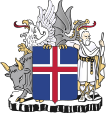| |||||||||||||||||||||||||||||||||||||||||||||||||||
All 63 seats in the Althing 32 seats needed for a majority | |||||||||||||||||||||||||||||||||||||||||||||||||||
| Turnout | 81.20% | ||||||||||||||||||||||||||||||||||||||||||||||||||
|---|---|---|---|---|---|---|---|---|---|---|---|---|---|---|---|---|---|---|---|---|---|---|---|---|---|---|---|---|---|---|---|---|---|---|---|---|---|---|---|---|---|---|---|---|---|---|---|---|---|---|---|
This lists parties that won seats. See the complete results below.
| |||||||||||||||||||||||||||||||||||||||||||||||||||
 |
|---|
|
|
Parliamentary elections were held in Iceland on 28 October 2017. On 15 September 2017, the three-party coalition government collapsed after the departure of Bright Future over a scandal involving Prime Minister Bjarni Benediktsson's father writing a letter recommending a convicted child sex offender have his "honour restored".[1] Bjarni subsequently called for a snap election,[2] which was officially scheduled for 28 October 2017 following the dissolution of the Althing.
Though many opinion polls in the run-up to the election indicated an increase in support for the Left-Green Movement, the Independence Party retained its position as the Althing's largest party.[3] Following the election, four-party coalition talks led by the Left-Greens ensued; however, after the Progressive Party rejected the possibility, a three-party coalition led by the Left-Greens including the Independence Party and Progressive Party was negotiated. After formally receiving the mandate to form a coalition on 28 November, Left-Green leader Katrín Jakobsdóttir was designated Prime Minister to lead the new government on 30 November.
Cite error: There are <ref group=n> tags on this page, but the references will not show without a {{reflist|group=n}} template (see the help page).
- ^ Milne, Richard (15 September 2017). "Paedophile rehabilitation scandal brings down Iceland's coalition". Financial Times. Archived from the original on 10 October 2017. Retrieved 15 September 2017.
- ^ Henley, Jon (15 September 2017). "Row over sexual abuse letter brings down Iceland's government". The Guardian. Archived from the original on 15 September 2017. Retrieved 15 September 2017.
- ^ "FINAL RESULTS: General Elections in Iceland bring a complicated political landscape". Iceland Monitor. Archived from the original on 29 October 2017. Retrieved 29 October 2017.
